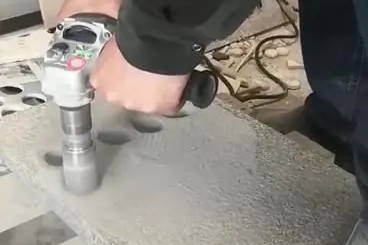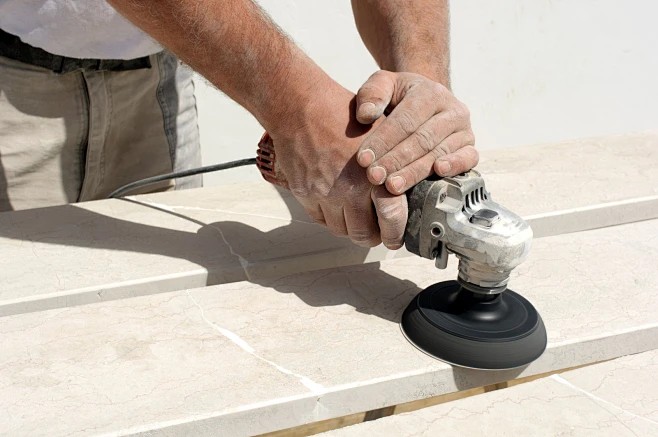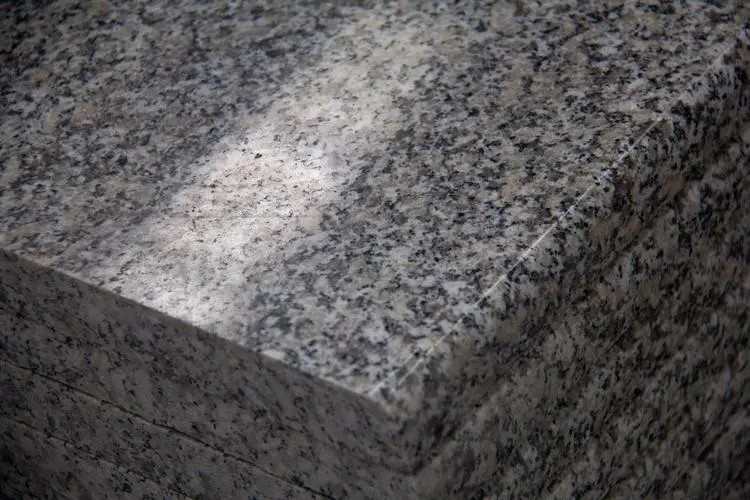Granite Processing: Drilling, Polishing and Matting Techniques
Known for its durability, beauty, and versatility, granite is a building material widely used in a variety of construction and design applications. Granite processing involves several basic steps, including drilling, polishing, and matting. Each of these processes plays a vital role in shaping and refining granite to achieve the desired aesthetic and functional properties. In this article, we will look at the drilling, polishing, and matting processes in granite processing and their applications and effects.
Understanding the Drilling Process in Granite Processing
Drilling is a fundamental technique in granite processing and is commonly used to create washbasins, faucet holes, and other perforations required for various applications.

Drilling technology in granite processing
The drilling process in granite processing involves the use of specialized equipment, usually a drill bit, to create precise perforations in the granite material. This process is critical to customizing holes in different shapes and sizes to meet specific installation requirements. By choosing the right drill bit and using precise technique, operators can achieve precise penetrations in granite, allowing for seamless installation of fixtures and fittings.
Key steps in the drilling process
Determine location and size: Before starting the drilling process, you need to determine the exact location and size of the punch hole. Use a marking tool to mark the designated location of the hole on the granite surface to ensure precision and accuracy during the drilling process.
Select the drill bit: According to the specific design requirements, select the appropriate drill bit to achieve the required hole diameter and depth. Drill bit selection is critical to achieving precise penetrations that comply with installation specifications.
Operate the drill: Operate the drill at the appropriate speed and pressure to initiate the drilling process. Careful control of drilling speed and pressure is essential to achieve precise penetration without damaging the granite material.
Applications and advantages of drilling technology
The drilling process in granite processing allows the flexibility to customize holes of different shapes and sizes to meet different installation requirements. For example, when making a washbasin, tap holes can be drilled to the exact size and shape of the fixture, ensuring a perfect fit and seamless installation. The ability to customize perforations according to design specifications enhances granite’s versatility and functionality in a variety of construction and design applications.
In summary, the drilling process is a key technology in granite processing, allowing precise perforations to be customized to meet specific installation requirements. With the proper equipment and techniques, operators can achieve precise perforations in granite, enhancing its functionality and versatility in construction and design projects.
Enhancing Granite Surfaces: The Polishing Process
Polishing plays a key role in granite processing, enhancing its aesthetic appeal and tactile qualities.

The Importance of Polishing in Granite Processing
Known for its durability and natural beauty, granite undergoes a transformative process through polishing. The polishing process helps refine the granite surface, enhancing its shine, texture, and overall visual appeal. By using specialized polishing machines and diamond polishing pads, the rough parts of the granite surface are carefully treated to achieve a smooth, shiny, and visually attractive surface.
Steps in the polishing process
The polishing process usually consists of three key stages: coarse grinding, medium grinding, and fine grinding. First, a coarse grinding disc is used to remove surface imperfections and unevenness, preparing the granite for further refinement. Subsequently, moderate grinding further enhances the gloss and smoothness of the granite surface. Finally, fine grinding ensures the granite surface achieves a dazzling polish, revealing its natural luster and beauty.
Benefits of the polishing process
The polishing process brings many benefits, significantly improving the visual and functional quality of your granite surface. Polishing gives granite a naturally beautiful luster, enhancing its visual impact and tactile appeal. Additionally, a polished surface not only looks great but is also easier to clean and more resistant to stains and abrasion. The enhanced durability and resiliency of polished granite make it ideal for a variety of architectural and design applications.
Effect of polishing on granite surface
The impact of the polishing process on the surface of granite is profound, enhancing its aesthetic and functional properties. Polished granite surfaces exude a naturally attractive sheen that enhances visual appeal and creates a feeling of elegance and sophistication. Additionally, the smooth, refined texture of polished granite’s surface enhances its tactile qualities, making it ideal for countertops, flooring, and decorative features in architectural and design projects.
In summary, the polishing process is a vital step in granite processing that enhances the visual appeal, feel, and durability of your granite surface. Using precise techniques and specialized equipment, the polishing process transforms rough granite into a refined and visually appealing material suitable for a wide range of architectural and design applications.
Granite Matte Finish Process
Matte is a surface treatment technology that provides a unique semi-gloss effect, providing an alternative to traditional polishing and frosting methods.

The significance of matte finish in granite processing
The matte process is an essential surface treatment technology in granite processing, providing a unique semi-gloss effect that strikes a balance between traditional polishing and frosting methods. By using specialized matte agents and polishing pads, the matte finish process enhances the visual appeal and tactile qualities of granite surfaces, creating a softer, more natural look.
Key steps in the matte process
The matte process is usually carried out after the polishing stage, utilizing specialized matte agents and polishing pads to achieve the desired semi-gloss effect. The application of these agents and pads reduces the intensity of reflected light, resulting in a softer, softer appearance while maintaining the smoothness of the granite surface. The matte finish process helps enhance the texture and color of the granite, providing a unique visual and tactile experience.
Advantages of the matte treatment process
The matte finish process offers a range of benefits that significantly enhance the visual and functional quality of granite surfaces. By reducing the intensity of reflected light, a matte finish creates a softer, more natural look, making granite surfaces less susceptible to fingerprints and stains. Additionally, a matte finish can more prominently showcase the grain and color of your granite, adding depth and character to the surface.
The impact of matte finishes on granite surfaces
The effect of the matte finish process on the granite surface is profound, providing a unique visual and tactile experience. The semi-gloss effect achieved through a matte finish process offers an alternative to traditional polishing and frosting methods, allowing for greater versatility in design applications. Enhanced durability and resistance to fingerprints and stains make matte granite surfaces ideal for a variety of architectural and design projects.
In summary, the matte treatment process is a key technology in granite processing, providing a unique semi-gloss effect that enhances the visual appeal and functionality of the granite surface. By using precise techniques and specialized reagents, the matte finish process transforms granite into a refined and visually appealing material suitable for a wide range of architectural and design applications.
Application and Effects of Drilling, Polishing, and Matte Processes in Granite Processing
Drilling technology: applications and effects
The drilling process in granite processing has many applications in construction and interior decoration. In kitchen designs, granite countertops often require drilling to accommodate sinks and stoves, while in bathrooms, granite washbasins and bathtubs require drilling to accommodate faucets and drains. The drilling process can be customized with different shapes and sizes of holes to meet specific installation requirements and ensure seamless integration of fixtures and fittings.
Polishing process: applications and effects
The polishing process is a key step in granite processing, offering a range of applications and effects in architecture and interior design. Polishing can be applied to granite floors, walls, countertops, and other surfaces to enhance their visual appeal and functionality. Polished granite flooring has a smooth surface and high gloss, creating a bright and luxurious atmosphere in indoor spaces. Not only is a polished surface visually appealing, but it's also easier to clean and more resistant to stains and abrasion, making it ideal for high-traffic areas.
Matte process: applications and effects
The matte finish process provides a unique semi-gloss effect that gives granite surfaces a modern and textured look. A matte finish after the polishing stage reduces the intensity of reflected light, creating a softer, more natural look. Matte-finished granite walls and countertops provide a semi-gloss effect that showcases the grain's texture and color while increasing resistance to fingerprints and stains. The matte finish process provides a versatile and modern aesthetic, making it suitable for a wide range of architectural and interior design applications.
In Summary
The drilling, polishing, and matte processes in granite processing are key steps to achieve the beauty and practicality of granite. These processes offer different applications and effects, allowing granite surfaces to be customized to meet specific design and installation requirements. Through the selection and implementation of these processes, granite products can achieve optimal visual appeal, texture, and functionality, providing a quality material choice for construction and interior decoration projects. The versatility and adaptability of these processes make granite ideal for a variety of design applications, helping to create stunning visual and functional spaces.
 English
English  Português
Português  русский
русский  Chinese
Chinese  French
French  Japanese
Japanese  Spanish
Spanish 



